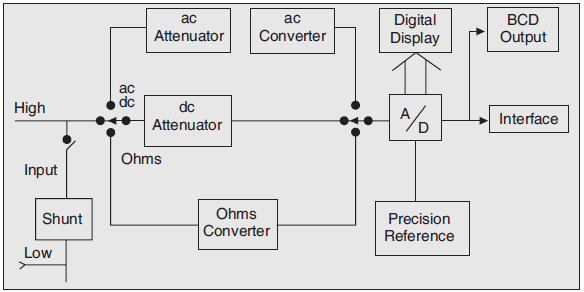Table of Contents
Digital Multimeter
A digital multimeter (DMM) displays the quantity measured as a number, it eliminates parallax errors.
Definition
A multimeter is an electronic instrument that can measure resistance, currents, and voltages. It is a versatile instrument and can be used for measuring D.C. as well as A.C. voltages and currents.

A basic block diagram of a digital multimeter (DMM) is shown in the above figure. The information from the analog input signal passes through the various analog signal conversion circuits which convert the measured quantity to a dc voltage equivalent. Then the A/D converts the dc value to digital form and displays the unit display the value. The DMM is made up of the following three basic elements:
- Signal conditioning
- Analog-to-digital (A/D) conversation
- Numeric digital display
Features of Basic Digital Multimeter
The main features of any digital multimeter is the types of measurement and the ranges over which it will operate. Most DMMs will offer a variety of measurements. The basic measurements will include:
- Current (DC)
- Current (AC)
- Voltage (DC)
- Voltage (AC)
- Resistance
Block Diagram of Digital Multimeter
The digital multimeter can measure ac voltage, dc voltage, ac current, dc current, and resistance over several ranges. The basic circuit is shown in Fig. 6.25.

For D.C. voltage measurement
For DC voltage measurement by DMM, a wide range of DC voltage inputs is scaled to the limited range of the A/D Converter. A resistive divider and switching are generally used for this function.
For A.C. voltage measurement
The signal is converted to a DC equivalent before sending it to the A/D Converter.
For D.C. and AC current measurement
It is necessary to convert the current at the input to a voltage. This is done through a series of switched resistors, called shunts. AC current is converted into DC by rectifiers and filters circuit.
For resistance measurement
It is necessary to create a voltage proportional to the resistance because A/D Converter measures only DC volts. The DMM input circuit must provide a DC current flowing through the resistor and then measure the resulting voltage.
To measure the unknown current with DMM we have to first convert the current to the voltage with the current to the voltage converter as shown in the figure below. The current to voltage circuit is implemented in DMM.
The known current is applied at the input of the op-amp. When the input current of an op-amp is zero, the current IR is almost the same as I1. This current IR causes the voltage drop, which is proportional to the current to be measured. This voltage drop is the analog input to the analog to digital converter.

Functions of a digital multimeter. Measurement of
- Voltages
- Currents
- Resistances
Multimeter as Voltmeter
In a.c voltage mode, the applied a.c. input voltage is fed through a calibrated, compensated attenuator, hare the input voltage is attenuated to a suitable level which is accepted by the succeeding stages. This attenuated voltage is converted into dc by a suitable precision a.c to d.c converter which consists of a precision full rectifier circuit followed by a ripple reduction filter. The resulting d.c is fed to the ADC (Analog to Digital Convertor) and the subsequent1 decoder and display system which displays the output in numerical form.
Multimeter as Ammeter
For current measurements, the current is applied to the shunt and the drop across an internally calibrated shunt is measured directly by ADC in the d.c. current mode. Due to the lack of precision in the a.c/d.c conversion, the accuracy in the a.c ranges is in general of the order of 0.2 to 0.5%. In addition, the measurement range is often limited to about 50 Hz at the lower frequency end owing to the ripple in the rectified signal becoming a non-negligible percentage of the display and hence the resulting function of the displayed number. At the higher frequency end, deterioration of performance of the a.c/d.c converter limits the accuracy. The a.c measurement range is often average reading, RMS calibrated.
Multimeter as an ohmmeter
For resistance measurement, the DMM operates by measuring the voltage across the externally connected unknown resistance, resulting from a current forced through it from a calibrated current source. The accuracy of the resistance measurement is of the order of 0.1 to 0.5% depending on the accuracy and stability of the internal current sources. The accuracy may be poorer in the higher range which is often about 10 or 20 MΩ. In the lowest range, the full scale may be approximately 200 Ω with a resolution of about 0.01 Ω for four-digit DMM.
Applications of Digital Multimeters
- For checking circuit continuity.
- It is used for measuring d.c voltage across various resistors in electronic circuits.
- For measuring a.c voltages across power supply transformer.
- For ascertaining whether or not open or short circuit exists in the circuits under study.
Merits and Demerits of Multimeters
Multimeters are widely used for manufacturing and servicing of electronic equipment, it has its own merits and dements
Merits
- It is a single meter that performs several measuring functions.
- Digital Multimeter has a small size and is easily portable.
- It can make measurements with reasonable accuracy.
Demerits
- It is a costly instrument.
- It cannot make precise and accurate measurements due to the loading effect.
- Technical skill is required to handle it.


